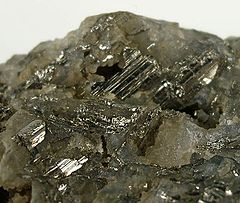Calaverite
| Calaverite | |
|---|---|

Platy calaverite crystals on matrix from the Cripple Creek District (size: 6 x 5 x 3.5 cm)
|
|
| General | |
| Category | Telluride mineral |
|
Formula (repeating unit) |
AuTe2 |
| Strunz classification | 2.EA.10 |
| Crystal system | Monoclinic |
| Crystal class | Prismatic (2/m) (same H-M symbol) |
| Space group | C2/m |
| Unit cell | a = 7.19 Å, b = 4.4 Å, c = 5.08 Å; β = 90.3°; Z = 2 |
| Identification | |
| Formula mass | 452.17 g/mol |
| Color | Brass yellow to silver white |
| Crystal habit | Bladed and slender striated prisms, also massive granular |
| Twinning | Common on [110] |
| Cleavage | None |
| Fracture | Uneven to subconchoidal |
| Tenacity | Brittle |
| Mohs scale hardness | 2.5-3 |
| Luster | Metallic |
| Streak | Green to yellow grey |
| Diaphaneity | Opaque |
| Specific gravity | 9.1-9.3 |
| Optical properties | Anisotropic |
| Pleochroism | Weak |
| Ultraviolet fluorescence | None |
| References | |
Calaverite, or gold telluride, is an uncommon telluride of gold, a metallic mineral with the chemical formula AuTe2, with approximately 3% of the gold replaced by silver. It was first discovered in Calaveras County, California in 1861, and was named for the county in 1868.
The mineral often has a metallic luster, and its color may range from a silvery white to a brassy yellow. It is closely related to the gold-silver telluride mineral sylvanite, which, however, contains significantly more silver. Another AuTe2 mineral (but with a quite different crystal structure) is krennerite. Calaverite and sylvanite represent the major telluride ores of gold, although such ores are minor sources of gold in general. As a major gold mineral found in Western Australia, calaverite played a major role in the 1890s gold rushes in that area.
Calaverite occurs as monoclinic crystals, which do not possess cleavage planes. It has a specific gravity of 9.35 and a hardness of 2.5.
Calaverite can be dissolved in concentrated sulfuric acid. In hot sulfuric acid the mineral dissolves, leaving a spongy mass of gold in a red solution of tellurium.
Calaverite’s structure has been both an object of fascination and frustration in the scientific community for many years. Goldschmidt et al. indexed calaverite 105 crystals resulting in 92 forms but needed five different lattices to index all of the faces. This led to consideration that calaverite violated Haüy's Law of Rational Indices.
The introduction of X-ray diffraction did not completely solve this problem. Tunell and Ksanda in 1936 and then Tunell and Pauling in 1952 solved the C2/m general structure of calaverite. However, additional diffraction spots which they could not interpret were present in the survey. Later, transmission electron microscopy study suggested that the satellite reflections in calaverite were due to Au in incommensurately displacive modulation superimposed on the average C2/m structure. In 1988, Schutte and DeBoer solved the structure by using the 3H super space group C2/m (α O γ)Os. They also showed that these modulations consist mainly of the displacements of tellurium atoms and the observed modulations were interpreted in terms of valence fluctuations between the Au+ and Au3+. According to Schutte and DeBoer, those displacements also affect the coordination number of calaverite.
...
Wikipedia
